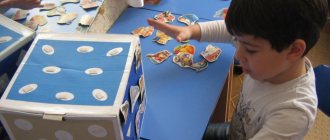Classification of games
Dear friends, we are pleased to introduce you to Kuzmina Lyudmila Valerievna, teacher of the State Budgetary Educational Institution Secondary School No. 2 named after. V. Maskina joint venture kindergarten “Alyonushka” st. Klyavlino, Samara region. Today Lyudmila Valerievna is pleased to bring to your attention an article on the topic “Classification of Games”. This material will be useful to teachers and parents.
A short commentary on the article from Lyudmila Valerievna:
“Children’s games are a heterogeneous phenomenon. Even a layman’s eye will notice how diverse games are in their content, the degree of independence of children, forms of organization, and game material. In pedagogy, repeated attempts have been made to study and describe each type of game, taking into account its functions in the development of children, and to give a classification of games.”
Interesting reading...
Classification of games
Children's games are a heterogeneous phenomenon. Even a layman’s eye will notice how diverse games are in their content, the degree of independence of children, forms of organization, and game material. In pedagogy, repeated attempts have been made to study and describe each type of game, taking into account its functions in the development of children, and to give a classification of games. This is necessary for an in-depth study of the nature of the game, the characteristics of each of its types, as well as to determine how one can influence children’s games, enhancing their developmental impact, using pedagogically competently in the educational process.
Due to the diversity of children's games, it turns out to be difficult to determine the initial basis for their classification. Each game theory proposes criteria that meet a given concept. Thus, F. Froebel was the first teacher to put forward the thesis about play as a special means of education, basing his classification on the principle of the differentiated influence of games on the development of the mind (mental games), external senses (sensory games), and movements (motor games). The German psychologist K. Gross also has a description of the types of games according to their pedagogical significance: active, mental, sensory games that develop the will are classified by K. Gross as “games of ordinary functions.” The second group of games, according to his classification, are “games of special functions.” These games are exercises to improve instincts (family games, hunting games, courtship, etc.).
In domestic preschool pedagogy, a classification of children's games has developed, based on the degree of independence and creativity of children in the game. Initially, P. F. Lesgaft approached the classification of children's games according to this principle. Later, his idea was developed in the works of N.K. Krupskaya.
P.F. Lesgaft believed that preschool age is a period of imitation of new impressions and their awareness through mental work. In the first 6-7 years of life, a child’s desire to reflect and comprehend impressions about the life around him is satisfied in games that are imitative in content and independent in organization, without unnecessary regulation on the part of adults. During school years, on the contrary, children are more willing to play specially created games in which activities are regulated both in content and form. Thus, P.F. Lesgaft divided children's games into two groups: imitation (imitative) and active (games with rules).
P. F. Lesgaft’s “tying” of each type of game to a specific age may seem untenable for a modern teacher who cannot imagine raising a child without a kindergarten, where games with rules occupy one of the main places in the pedagogical process, starting with younger groups. The situation was completely different in those years when P.F. Lesgaft proposed his classification in his book “Family education of a child and its significance.” There were very few kindergartens in Russia at that time; children under 8 years of age were raised at home, so outdoor games mainly began at school age.
In the works of N.K. Krupskaya, children's games are divided into two groups according to the same principle as in P.F. Lesgaft, but they are called a little differently: games invented by the children themselves, and games invented by adults. Krupskaya called the first ones creative, emphasizing their main feature - their independent character. This name has been preserved in the classification of children's games, traditional for domestic preschool pedagogy. Another group of games in this classification are games with rules. Like any classification, this classification of children's games is conditional.
Modern domestic pedagogy includes role-playing games, construction games and dramatization games as creative games. The group of games with rules includes didactic and outdoor games.
Construction games help a child understand the world of structures and mechanisms created by human hands. Therefore, the prerequisites for their occurrence are the same as for the plot-role-playing game. If in a role-playing game the sphere of relationships between people is modeled, then in a construction game it is the sphere of creation, the creation of architectural structures. The need for buildings may arise during the course of the role-playing game.
Any construction game contains the intellectual task “How to build?”, which the child solves with the help of various materials and actions. Expanding children’s ideas about the surrounding man-made world, acquiring communication skills and technical, “construction” skills leads to the emergence of collective construction games. Theatrical games, or dramatization games, are a type of creative play. In games, children express their impressions and experiences and master them in activities in direct contact with each other.
In a dramatization game, as in a plot-role-playing game, there is a plot, roles, game actions, and role players. It is also characterized by attributes, game objects, masks, decorations, a detailed system of real relationships between players, a combination of role-playing and real actions and relationships, independence and self-organization of children. During the game, children emotionally master problem situations, penetrate into the inner meaning of the characters’ actions, and they form an imaginary image and an evaluative attitude towards the character.
The structure of outdoor games includes game actions, rules and material, and often also a role and plot. The rules in such games are formulated before the game begins. Submission to the rule is associated with the development of voluntary movements, when it is necessary to restrain immediate impulses (not to run away from the “bear” until a certain signal), to slow down actions, as in the game “Day and Night,” or to change them at the signal of the leader, as in the game “The Sea Is Troubled” " In competition games and relay games, a senior preschooler learns to maintain the goal of an activity, act according to an adult’s instructions, and control his behavior and actions.
A special type of gaming activity is a didactic game. It is specially created by adults for educational purposes, and then learning proceeds on the basis of a gaming and didactic task. In didactic play, the child not only gains new knowledge, but also generalizes and consolidates it. Preschoolers develop cognitive processes and abilities, they assimilate socially developed means and methods of mental activity.
The main goal of any didactic game is educational. Compliance with the rules is an indispensable condition for solving gaming and didactic tasks. The rules in the didactic game perform various functions. They direct the game along a given path, combining didactic and game tasks, determine the sequence of game actions, increase the entertainment of the game, allow the teacher to indirectly manage it, regulate the relationships of the participants and form interpersonal relationships. Gaming and didactic tasks are realized in game actions. The means of solving a didactic task is didactic material. The result of a didactic game is the solution of gaming and didactic problems.
The presence of a plot and role in a didactic game is not necessary.
It would be a mistake to think that there is no place for children's creativity in didactic games. In games with fixed rules (moving, didactic), children show creativity, coming up with new options, using new game material, combining several games into one, etc. For example, a new game appeared in the older group - “Zoological Lotto”. The presenter opens small cards one by one and shows them to the players. A few days later, one of the children says: “It’s not interesting to play like this: I looked at the picture and found the animal in my card. Let the presenter simply name the animal and not show the card.” Then the children come up with another option: the leader says where the animal lives and what letter its name begins with. There can be many such complications, it all depends on the imagination of the players. But the child’s focus on solving the game problem within the framework of the accepted rules remains unchanged.
On the other hand, it would be wrong to imagine that in creative games there are no rules governing the relationships between the players and the ways of using the game material. These rules, firstly, are determined by the children themselves, trying to organize the game (after the game, everyone will put away the toys; when agreeing on the game, you need to listen to everyone who wants to play). Secondly, some of them are hidden. Thus, children refuse to accept a child into the game because he always starts quarrels and interferes with play, although they do not first stipulate the rule “We will not accept into the game someone who quarrels.” Thus, in creative games, rules are necessary to streamline activities and democratize them, but they are only a condition for the successful implementation of a plan, plot development, and fulfillment of roles.
In conclusion, I would like to note that play, like any creative activity, is emotionally rich and brings joy and pleasure to every child by its very process.
The teacher must create a joyful, cheerful mood in the children during the game. Positive emotions are the key to a child’s full physical and neuropsychic development, as well as a condition for developing a cheerful, friendly character.
Game as a type of activity for a preschooler
Raising a free, self-confident person with an active life position, striving to take a creative approach to solving various life situations, having his own opinion and being able to defend it - this is the priority of the “From Birth to School” Program [1].
Game is one of those types of children's activities that are used by adults to educate preschoolers, teach them different actions with objects, methods and means of learning. In play, a child develops as a personality, he develops those aspects of his psyche on which the success of his educational and work activities, and his relationships with people will subsequently depend. Play is a special form of social life for preschool children, in which they unite at will, act independently, realize their plans, and explore the world. Independent play activities contribute to the physical and mental development of the child, the development of moral and volitional qualities, and creative abilities. The tasks of comprehensive education in play are successfully implemented only if the psychological basis of play activity is formed in each age period of early and preschool childhood. This is due to the fact that the development of play is associated with significant progressive transformations in the child’s psyche, and above all in his intellectual sphere, which is the foundation for the development of all other aspects of the child’s personality [5]. It is the teacher who must properly organize games that are not only interesting, but also bring maximum benefit to the comprehensive development and education of preschoolers.
There are three types of activity that genetically replace each other and coexist throughout the entire life course: play, learning and work. They differ in the final results of their activities, in their organization, and in the characteristics of their motivation.
The game does not create a socially significant product. The formation of a person as a subject of activity begins in the game, and this is its enormous, enduring significance. Training is the direct preparation of an individual for work, develops it mentally, physically, aesthetically, and only at the final stage of mastering a profession is it associated with the creation of material and cultural values. Labor is the process of human creation of material and spiritual values of society.
The game is organized freely and unregulated. No one can oblige a child to play board games from 10 to 2 o'clock, and after 2 o'clock - mother and daughter games. A child’s play can be organized, but he must accept what is proposed. This does not mean that the child should not have a strict daily routine. Sleep, food, walks, play and activity times must be strictly defined. But the content of the game, the child’s involvement in it, and the termination of the game are difficult to regulate. The child himself moves from one game to another [5]. Learning and work take place in organizational forms obligatory for a person. Classes begin according to the schedule, and throughout the lesson the student is engaged in this particular subject. So, different forms of organizing activities are also associated with their different motivations. The motive of the game is the pleasure that the child experiences from the very process of the game.




